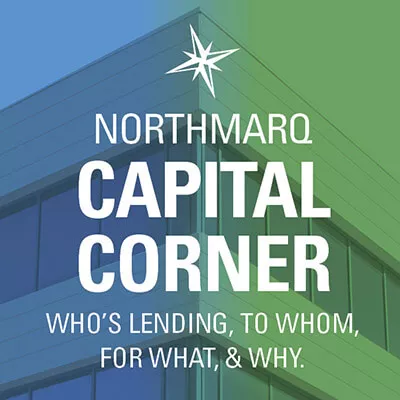Capital Corner: Lenders bring new level of creativity into the New Year
Institutional money looking for a home

Lenders came out of 2020 with experience in adapting to change during one of the most challenging years on record. With that experience, some have identified new programs, and new markets, and are giving some traditional programs a refresh to respond to market demand.
NorthMarq experienced that same drive for creativity, as we worked with clients to uncover new opportunities for capital, leading to our best year ever in all lender categories. As we move into 2021, we expect a continued search for yield with lenders, meaning that borrowers can expect to see new programs to consider for each stage of property ownership.
Life Companies
Life companies came out of their mid-2020 pause with a continued focus on multifamily and industrial, which allowed some life company lenders to have record volume production.
Multifamily is still the darling property type for most life company lenders. The creation of bridge programs helped attract properties in the pre-leasing phase as well as for value-add properties planning for renovations and rent growth. These bridge programs translate easily into permanent structures, simplifying the transaction for borrowers.
Industrial was also a highly sought-after asset class for life companies in 2020; this hot commodity’s only issue is that there isn’t enough of it to quench the appetite for lenders, who are open to all industrial in almost every market across the U.S.
Allocations for 2021 will see new ideas and programs for chasing yield. Lenders are reconsidering service-driven and food-anchored retail and office assets with strong leasing fundamentals. Flex space experienced renewed demand as pandemic concerns highlighted some of their characteristics; ample parking, access to space without sharing common areas, signage, and suburban locations that don’t require mass transit. Whether CBD office or suburban office wins the day when employees return to physical space has yet to be seen, but most are betting that suburban office will be the winner.
Equity
Equity sources continue to look for opportunities to invest within the housing market. The workforce housing space has renewed attention from institutional investors as they compete with private capital to secure assets. Once firms can travel more to visit properties around the country, we expect to see equity sources expand their reach, given the demand from across the world to participate in US commercial real estate as an asset class.
Investors will need to get comfortable with the pricing throughout the multifamily space especially initial yields on new construction. Costs continue to fluctuate while lease-rates in Class A have leveled off and are offering concessions to lease-up. Return on cost metrics, as an example, will need to be flexible as the market recovers with the economy. Some sources take comfort that starting a project today will allow 12-18 months before the project is delivered allowing the markets to stabilize.
We also expect to see an increase in equity for industrial as the year progresses.
Fannie Mae
Fannie Mae ended 2020 on a high note, closing over $10 billion in multifamily debt in December alone, and $76 billion for the year. This represents the highest annual volume ever for Fannie Mae, approximately $6 billion above 2019 figures. Similarly, NorthMarq’s Fannie Mae volume hit an all-time high, up 35.5% from 2019.
Despite the tumultuous start to 2021, we feel there is a lot to be optimistic about in the coming year. The prospect of additional economic stimulus out of the Biden administration and the COVID vaccine rollout under way suggest that a return to normalcy may finally be on the horizon.
Additionally, economic indicators suggest there is significant pent-up demand in the multifamily space, with ample capital available to take advantage of those future opportunities. All of this points to substantial growth in the multifamily lending industry over the upcoming months as people return to work and look for housing. With interest rates continuing to price near all-time lows and the Fannie Mae program being as competitive as ever, NorthMarq is well-positioned to take advantage of the opportunities 2021 may bring.
Freddie Mac
With the New Year comes new opportunities and new challenges. Freddie Mac is expected to announce final 2020 production totals this week, which are expected to be right at their $80M allocation for the year. NorthMarq’s Freddie Mac volume increased 67% increase year over year from 2019 -- our best year ever.
The real question for Freddie Mac now is just how much business carried over into 2021.
With the recent uptick in Treasuries, business at Freddie has slowed slightly, helping staff to catch their breath, as well as plan for 2021 production. Borrowers continue to find fixed rates attractive and there has been increased activity on floating rate loans where maximum flexibility is needed. Freddie will be rolling out a new Green Retrofits program, aimed at deeply affordable properties that have already completed green improvements. Spreads continue to remain steady during January.
FHA/HUD
FHA entered 2021 with a substantial pipeline of new transactions and the prospect of healthy demand for the foreseeable future. This robust activity was evidenced by FHA closing approximately $19 billion of multifamily transactions in 2020, up from $12 billion in 2019. NorthMarq experienced similar year-over-year growth with 2020 loan volume up 120% over 2019. The combination of historically low-interest rates, along with high leverage and long mortgage terms positions FHA and NorthMarq for another strong year in 2021.
As expected, FHA released their revised MAP Guide in December 2020. In January 2021, FHA will be conducting several training/review sessions covering the provisions of the new MAP Guide. Due to Covid-19, FHA remains in a remote work environment as we enter 2021. This has been the case since late spring of 2020 and there has not been any meaningful impact due to working remotely. Given the increase in volume and the continued work-from-home environment, FHA has experienced transaction processing delays and is working on measures to help compress transaction timelines. NorthMarq continues to seek creative solutions to avoid unnecessary delays in processing. We are collectively taking actions to ensure deals move as expeditiously as possible.
FHA remains the best multifamily finance alternative for combining the lowest interest rates in the market with the highest possible leverage and longest loan terms available.
In Closing
Fear of the unknown will drive some activity as the year progresses – from the fear that interest rates will likely go up to the fear of changes coming from a new US administration – as investors leverage what’s on the table now. With no slowdown in capital to place from lenders and equity sources, borrowers remain well-positioned to leverage strong fundamentals to achieve the best pricing for all layers of the capital stack.
Insights
Research to help you make knowledgeable investment decisions

